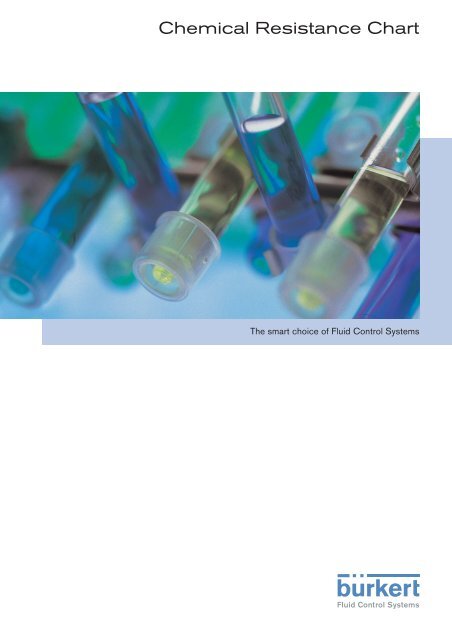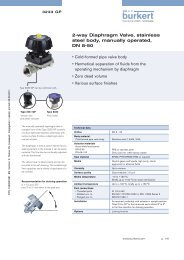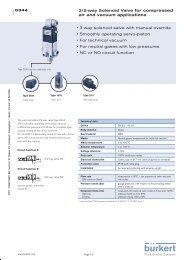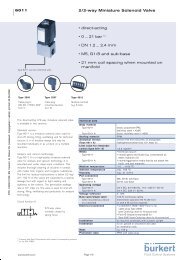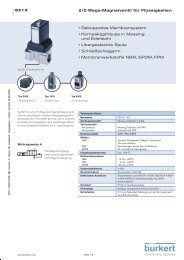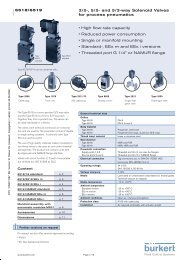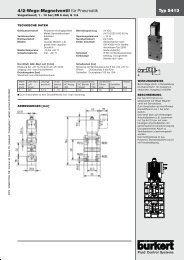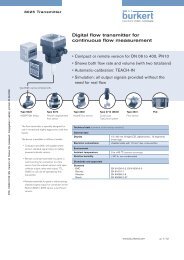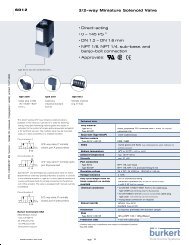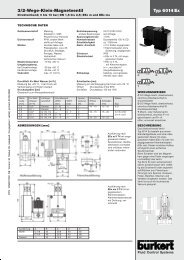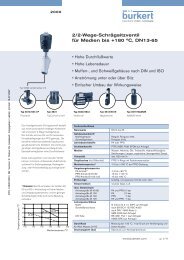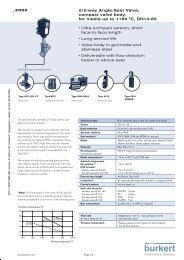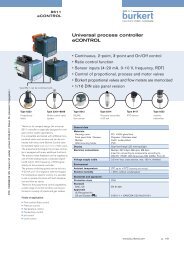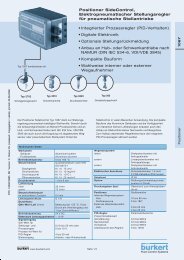Chemical Resistance Chart English - Burkert
Chemical Resistance Chart English - Burkert
Chemical Resistance Chart English - Burkert
Create successful ePaper yourself
Turn your PDF publications into a flip-book with our unique Google optimized e-Paper software.
<strong>Chemical</strong> <strong>Resistance</strong> <strong>Chart</strong>The smart choice of Fluid Control Systems
Contents1. General information and introduction1.1 Introduction Page 41.2 Structure and content of the chemical resistance charts Page 41.3 Interpretation of symbols Page 51.4 References Page 52. <strong>Chemical</strong> resistance properties gasketand housing materials2.1. Overview Page 62.2. <strong>Resistance</strong> in basic chemicals Page 82.3. <strong>Resistance</strong> in commercial products Page 202.4. <strong>Resistance</strong> in liquid foods and beverages Page 243
1. General information and introduction41.1IntroductionWhen dealing with aggressive fluidsthe user is continuously faced with theproblem of finding compatible materials.In order to simplify the selection ofsuitable materials when using Bürkertproducts for aggressive fluids, thefollowing tables provide useful informationon the optimal choice ofhousing and gasket materials for amultitude of media.Since corrosion performance is influencedby several factors, the informationcontained in this brochure should betreated only as a guide and is notnecessarily valid for all operating conditions.Increased temperatures, higher concentrations,and the inadvertent ingressof water in originally pure chemicalscan all lead to accelerated corrosion.Dependent on the purity of the fluid aswell as the compounding and natureof vulcanisation of the gasket materials,deviations can result which affect thesuitability and durability of the plasticsand elastomers.The information quoted in this guidedoes not consider the effect ofmechanical loading, which may alsohave a bearing on the material performancein the fluid. In cases ofdoubt when considering our products,we strongly recommend the prior testingof samples with various materialcombinations, in order to establishand check their suitability under theactual operating conditions of theapplication.Where liquid food products areinvolved, the plastics and elastomersemployed must normally conform withthe local food and hygiene regulations.It is emphasized that these resistancetables are intended only as a guideand that no guarantees can be givenin respect of the information containedin this publication.1.2Structure and contentof the chemicalresistance chartsThe following chemical resistance tablesare divided into three categories. Theseare basic chemicals (chapter 2.2),commercial products (chapter 2.3)and liquid food and beveragesingredients (chapter 2.4).The resistance of these fluids is ratedin detail for the elastomeric materials,plastics and metallic materials commonlyemployed in Bürkert products.Rarely used materials such as CSMas well as aluminum are not describedin the tables. Epoxy resin, which iscommonly used in the construction ofour products, but which is not mentioned,is resistant to most common chemicals.Information regarding the chemicalresistance of the unlisted materials isavailable on request, including chromeand nickel-plated parts. Please see theoverview in chapter 2.1 for additionalinformation regarding general chemicalresistance of seal and body materials.For the most commonly used chemicalsubstances the chemical formula isadded in the charts.The suffix "pure" means the technicalpureness of the fluid, which in mostcases exceeds 95% purity. As a rule,organic fluidic or gaseous media havethis supplement. "Acetic acid - pure"means for example a 98% acetic acid.
The suffix "aqueous" is mostly usedfor water miscible substances (suchas Ethanol) but also for aqueous solutionsof inorganic salts. Due to thegreat number of possible concentrations,an average concentration isalways assumed.Saturated aqueous solutions aredescribed only if explicitly noted andthe reference temperature for allstatements is room temperature.At higher temperatures a reducedchemical resistance must beconsidered.1.3Interpretation ofSymbols+ material is not affected or is slightlyaffected by the chemical: suitable$ various attack level depending onprevailing conditions: limitedsuitability– material exhibits severe attack:unsuitableIf materials are rated as "limited suitability",the time of impact has to beconsidered. At a long period of impactthese materials can be heavily attackedor even destroyed. Therefore theseparts are rated as wear parts and arenot included in the standard warrantyconditions.1.4ReferencesAll the information quoted in theseresistance tables is based on industrialexperience (for example "DECHEMA -Werkstoff-Tabelle", Germany or"DECHEMA Corrosion Handbook"),the data of our material and compoundmanufacturers and Bürkert's ownstringent laboratory tests.In many cases it is not possible tomake a clear statement due to differentservice conditions. In these cases therating should also be "limited suitability".5
2. <strong>Chemical</strong> resistance properties gasketand housing materials2.1OverviewMaterial Designation<strong>Chemical</strong> resistance Permissible temperaturesMagnet encapsulation materialsNeutral fluidslong-term °C(°F)Epoxy resin EP Resistant to nearly all chemicals. -20 (-4) toUnsuitable for short-chain organic +150 (+302)acids of high concentration andfor strong oxidising substances.Polyamide PA See plastic housing materialsNeutral fluids Aggressive fluidsshort-term °C(°F) long-term °C(°F)Gasket and diaphragm materialsEthylene propylene EPDM Good resistance to ozone and -30 (-22) to Dependantdiene rubber weathering. Particularly suitable +130 (+266) onfor aggressive chemicals.aggressive-Unsatisfactory for oils and fats.ness of thefluid andon mechanicalload.Fluorine rubber FKM <strong>Chemical</strong> properties superior to all -10 (+14) to -10 (+14) toother elastomers. +150 (+302) +200 (+392)6Nitrile rubber NBR Fairly resistant to oil and petrol. -10 (+14) to -10 (+14) toUnsatisfactory with oxidising fluids. +90 (+194) +120 (+248)Chloroprene rubber CR The chemical properties are very similar -10 (+14) to -10 (+14) to(Neoprene) to those of PVC and are between those +100 (+212) +110 (+230)of NBR and EPDM.Perfluorinated FFKM Similar to PTFE -50 (-58) to to+320(+608)elastomers (Simriz, (dependent on blend) +260 (+500) (only Kalrez)Kalrez, Chemraz)Poly tetrafluorethylene PTFE See plastic housing materials(Teflon)Steel 1.4112 -20 (-4) to -20 (-4) to+450 (+842) +150 (+302)
MaterialDesignation<strong>Chemical</strong> resistancePermissible temperaturesHousing materials - MetalStainless steel See resistance tables - 20 (-4) to -20 (-4) to+400 (+752) +150 (+302)1.4401 Also 1.4404, 1.4408, 1.4409, 1.44011.4571 Also 1.45811.4305 Also 1.4301, 1.43031.4104 Also 1.4105Grey cast iron GG 25 For neutral fluids -20 (-4) to+180 (+356)S.G. cast iron GGG 40.3 For neutral fluids -20 (-4) to+400 (+752)Cast steel GS – C For neutral fluids -20 (-4) toC22, C25 +400 (+752)Brass MS See resistance tables -20 (-4) to+250 (+482)Leaded red brass RG See resistance tables -20 (-4) to+250 (+482)Housing materials - PlasticNeutral fluids Neutral fluids Aggressive fluidslong-term °C(°F) short-term °C(°F) long-term °C(°F)Rigid polyvinyl PVC Resistant to most acids and bases, salt 0 (+32) to 0 (+32) to 0 (+32) tochloride solutions, and water miscible, organic solvents. +60 (+140) +60 (+140) +40 (+104)PVC-HT Non-resistant to aromatic and 0 (+32) to 0 (+32) to 0 (+32) tochlorinated hydrocarbons. +90 (+194) +110 (+230) +40 (+104)Poly propylene PP Resistant to organic solvents, aqueous 0 (+32) to 0 (+32) toPoly ethylene PE solutions of acids, bases and salts. +100 (+212) +60 (+140)Unsuitable for concentrated, oxidisingacids.Poly amide PA Resistant to fats, oils, waxes, fuels, 0 (+32) to 0 (+32) toweak bases, aliphatic and aromatic +100 (+212) +60 (+140)hydrocarbons.Poly tetrafluoro- PTFE Resistant to nearly all chemicals. -20 (-4) to -20 (-4) to -20 (-4) toehtylene Unsuitable for liquid sodium and +200 (+392) +260 (+500) +150(+302)(Teflon)fluorine compounds.Poly vinylidene PVDF Unsuitable for hot solvents as well as for -20 (-4) tofluoride ketones, esters, and strong bases. +100 (+212)Poly phenylene PPS Resistant to dilute mineral acids, bases, to +200 to +260sulfide aliphatic and aromatic hydrocarbons, (+392) (+500)ketones, alcohols, chlorinated hydrocarbons,oils, fats, water, and to hydrolysis.Poly ether ether PEEK Resistant to most chemicals. Unsuitable to +205 to +300ketone for concentrated sulfuric and nitric acid (+482) (+572)and certain chlorohydrocarbons.7
2.2<strong>Resistance</strong> in basic chemicalsNBREPDMFKMFFKMCRPTFEPVCPPPAPVDFPPSPEEKMSRGGG, GS1.4401/1.45711.4305/1.41048AAcetaldehyde - pure CH 3CHO – + $ + – + – $ $ + $ + + + – + +Acetic acid ethyl ester (ethyl acetate) - pure CH 3CO 2CH 2CH 3 – $ – $ – + – – $ $ + + – + + + +Acetic acid - pure CH 3COOH – $ – $ – + $ – $ + + + – – – + –Acetic anhydride - pure CH 3COOCOCH 3 – $ – $ – + – – – – + – $ $ $ $Acetoacetic ester (acid free, pure) CH 3COCH 2CO 2C 2H 5 – – – + – + – – + – + $ $ $ + +Acetone - pure CH 3COCH 3 – + – + $ + – + + – + + + + + + +Acetophenone - pure C 6H 5COCH 3 – – + – + – + $ $ + + + + +Acetylacetone - pure CH 3COCH 2COCH 3 – – – + – + – – + – – – $ + +Acetyl chloride - pure CH 3COCl – – – + – + – – + $ $ $ $ $Acetylene - pure HCCH – + – + – + $ $ + + + + 1 + – + + +Acrylic acid ethyl ester - pure CH 2CHCOOC 2H 5 – $ – + – + – $ + + + +Acrylonitrile - pure CH 2CHCN – – – + – + – + $ – + + + + + + +Adipic acid - aqueous (saturated) HO 2C(CH 2) 4CO 2H + + + + + + + + + + + + + +Albumin solutions + + + + + + + + $ $ $ + +Alum (potassiumaluminiumsulphate)-aqueous (saturated) KAl(SO 4) 2*12 H 2O + + + + + + + + + + + + – – – + $Albumin - pure + + + + + + + + $ $ $ + +Allyl alcohol - pure CH 2CHCH 2OH + + – + – + – + + + + + + – + +Aluminium acetate - aqueous (saturated) Al(OOCCH 3) 3 $ + + + + + $ + + + + $ $ – + +Aluminium chloride - aqueous (saturated) AlCl 3 + + + + + + + + $ + + + $ $ $ $ $Aluminium fluoride - aqueous (saturated) AlF 3 + + + + + + + + + + + + + $ – –Aluminium sulfate - aqueous (saturated) Al 2(SO 4) 3 + + + + + + + + $ + + + – – – $ $Aminoacetic acid (glycocoll) NH 2CH 2COOH $ + + + + + + $ + + $ $ $ + +Ammonia - anhydrous (liquid) - pure NH 3 – 2 $ – $ – + – – + – $ + $ $ + + +Ammonia (gas) - pure NH 3 – + – $ + + – – + – $ + – – + + +Ammonium hydroxide solution NH 4OH – + – + + + + + + + $ + – – + + +Ammonium acetate - aqueous CH 3COONH 4 + + + + + + + + + + $ $ $ + +Ammonium carbonate - aqueous (NH 4) 2CO 3 + + + + + + + + + + + – – $ + +Ammonium chlorid - aqueous NH 4Cl + + + + + + + + + + + + $ $ $ $ $Ammonium citrate - aqueous + + + + + + + + $ + $ $ $ + +Ammonium fluoride - aqueous NH 4F + + + $ $ + + + + + $ $ $ $ $Ammonium fluorsilicate - aqueous + + + + + + + + $ + $ $ $ + +Ammonium formiate - aqueous HNCOONH 4 + + + + + + + + + + $ $ $ + +Ammonium nitrate - aqueous (saturated) NH 4NO 3 + + + + + + + + + + + + - - $ + +Ammonium oxalate - aqueous NH 4O 2CCO 2NH 4 + + + + + + + + $ $ $ $ + +Ammonium persulfate - aqueous (NH 4)S 2O 8 - + + + $ + $ + - + $ $ - $ $Ammonium phosphate - aqueous (NH 4) 2HPO 4 + + + + + + + + + + + $ $ + + +Ammonium thiocyanate - aqueous NH 4NCS + + + + + + + + - - $ + +
NBREPDMFKMFFKM (Simriz)CRPTFEPVCPPPAPVDFPPSPEEKMSRGGG, GS1.4401/1.45711.4305/1.4104Chloral hydrate (chloral) - aqueous CCl 3CH(OH) 2 – $ $ + – + – – – – $ $ $ $ $ $Chlorbenzenes - pure C 6H 5Cl – – – + – + – – + + – + + + + + +Chloric acid - aqueous HClO 3 – $ – + – + + – – + – – – – –Chlorine (gas) - dry Cl 2 – – $ + – + – – – + – + – – – + –Chlorine (gas) - wet (chlorinated water) Cl 2 – – $ $ – + – – – $ – – – – – – –Chlorine (liquid) - pure Cl 2 – – $ + – + – – – + – – – – – + +Chlorine dioxide - aqueous ClO 2 – – – $ – + + $ – $ – – $ $ $Chloroacetic acid - aqueous ClCH 2COOH – $ – + – + $ – – + + + $ – $ $ –Chloroethanol (ethylene chlorhydrine) - pure ClCH 2CH 2OH – – $ + – + – + $ + $ $ + + + + +Chloride of lime (calcium hypochlorite) - aqueous Ca(OCl) 2 – + $ + $ + $ + – + – + – – $ $ $Chlorinated water (chlorine gas - wet) Cl 2 – – $ $ – + – – – $ – – – – – – –Chlormethane (methyl chloride) - pure ClCH 3 – – + + – + – – $ – $ + + + – + +Chloronaphtalene - pure C 10H 7Cl – – $ + – + – – + $ + + + + +Chloroform (trichloromethane) - pure CHCl 3 – – + + – + – – – + $ + + + – + +Chlorophenol - pure C 6H 4(OH)(Cl) – – – + – + $ $ + + $ + +Chlorophenoxyacetic acid (OC 6H 5)(Cl)CHCOOH + + + + + + + $ + +Chlorsulfonic acid - pure ClSO 3H – – – $ – + $ – – $ – – $ $ $ $ $Chlorxylenol - pure C 6H 2(OH)(CH 3) 2(Cl) – – – + – + $ + + $ + +Choline chloride - aqueous [HOCH 2CH 2N(CH 3) 3]Cl + + + + + $ $ – – $Chromic acid - aqueous H 2CrO 4 – $ + + $ + + $ – + – $ – – $ $ $Chromium alum - aqueous KCr(SO 4) 2*12H 2O + + + + + + $ + $ + $ $ – $ $Chromium sulfate - aqueous Cr 2(SO 4) 3 + + + + + + + + $ + $ $ – $ $Citral (citronella oil) - pure – – – – + – + + + + $ + +Citric acid - aqueous + + + + + + + + + + + + $ + – + $Cresol - aqueous (lysol) C 6H 4(OH)(CH 3) – – $ + – + $ $ – $ + + + + $ + $Common salt (sodium chloride) - aqueous NaCl + + + + + + + + + + + + – $ – $ $Copper acetate - aqueous Cu(CH 3COO) 2 $ + + + + + + + $ + + + $ – $ + +Copper chloride - aqueous CuCl 2 + + + + + + + + $ + + + $ $ $ – –Copper sulfate - aqueous CuSO 4 + + + + + + + + $ + + + $ $ $ $ $Cyclohexane - pure C 6H 12 – – $ + – + + – + + + + + + + + +Cyclohexanol - pure C 6H 11OH – – + + + + $ + + + + + + + + + +Cyclohexanone (anone) - pure C 6H 10O – – – + – + – – + $ + + $ $ $ + +Cymene - pure C 6H 4(CH 3)[CH(CH 3) 2] – – – – + – – + $ + + + + +DDecahydronaphtalene (decalin) - pure C 10H 18 – – + + – + + $ + $ + + + + +Dextrose - aqueous C 6H 12O 6 + + + + + + + + + + + + + + + +Diacetone alcohol - anhydrous (CH 3) 2C(OH)CH 2COCH 3 – + – + $ + $ + $ + $ + +11
2.2<strong>Resistance</strong> in basic chemicalsNBREPDMFKMFFKM (Simriz)CRPTFEPVCPPPAPVDFPPSPEEKMSRGGG, GS1.4401/1.45711.4305/1.4104Dibutyl phthalate - pure C 6H 4(COOC 4H 9) 2 – $ – + – + $ $ + – + + + + + +Dibutyl sebacate - pure (C 4H 9COO)(CH 2) 8(OOC 4H 9) – $ – + – + – + + – + + + + + +Dichlorethane (ethylene chloride) - pure ClCH 2CH 2Cl – – – + – + – – + + $ + – – – + –Dichlorethylene - pure Cl 2CHCH 3 – – $ + – + – – + + $ + + + $ + +Dichlormethane (methylene chloride) - pure CH 2Cl 2 – – $ + – + – – – – $ $ + + – + +Dicyclohexyl-ammonium nitrite - pure [(C 6H 11) 2NH 2]NO 2 + + + + + + $ $ $ + +Diethyl ether - pure CH 3CH 2OCH 2CH 3 – – – + – + – – + + + + + + + + +Dimethyl amine - pure (CH 3) 2NH – $ – + – + – $ – – $ $ $ $ + +Dimethyl formamide - pure HCON(CH 3) 2 – – – + – + – + – – $ + $ $ $ + +Dimethyl sulfoxide - pure (CH 3) 2SO + + $ – + $Dioctyl phtalate - pure C 6H 4(COOC 8H 17) 2 – $ $ + – + – + + $ + + + + + +Dioxane - pure C 4H 8O 2 – $ – + – + – – + – + + + + + +Diphenyl + diphenyloxide – – – + – + – – + + + + + + +Dissousgas (acetylene + acetone) – + – – + – $ + + + + + +12EEthane - pure CH 3CH 3 + – + + + + – – + – + + + + + + +Ethanol (ethyl alcohol) - pure CH 3CH 2OH $ + $ + + + $ + $ + + + + + + + +Ethanolamine - pure NH 2CH 2CH 2OH $ $ – + $ + $ + + $ $ – – + + +Ether (diethyl ether) - pure CH 3CH 2OCH 2CH 3 – – – + – + – – + + + + + + + + +Ethyl acetate (acetic acid ethyl ester) - pure CH 3CO 2CH 2CH 3 – $ – $ – + – – $ $ + + – + + + +Ethyl alcohol (ethanol) - pure CH 3CH 2OH $ + $ + + + $ + $ + + + + + + + +Ethyl alcohol + acetic acid CH 3CH 2OH + CH 3COOH $ + $ + $ + $ + – + + + $ $ $ + +Ethyl alcohol - fermentation mash + + + + + + + + $ + + + + + $ + +Ethyl alcohol - denaturated (depending on denaturant) $ $ $ + $ + + + $ + + $ $ + + +Ethyl benzene - pure C 6H 5CH 2CH 3 – – $ + – + – – + + $ + + + + +Ethyl chloride - pure CH 3CH 2Cl + + + + + + – – + + $ – – – + +Ethyl formiate HCOOCH 2CH 3 – $ – + – + – $ + + + + + $ + +Ethylene - pure CH 2CH 2 + – + + – + + + + + + + + + + + +Ethylene chlorhydrine (chloroethanol) - pure ClCH 2CH 2OH – – $ + – + – + $ + $ $ + + + + +Ethylene diamine - pure NH 2CH 2CH 2NH 2 $ + $ $ + + – + $ + $ – – $ + $Ethylene dibromide - anhydrous CH 2CHBr – – – + – + – – + + $ – + + $ + +Ethylene dichloride (dichloroethane) - pure ClCH 2CH 2Cl – – – + – + – – + + $ + – – – + –Ethylene glycol (glycol) - pure HOCH 2CH 2OH + + + + + + + + $ + + + $ $ $ + +Ethylene oxide (liquid) - pure CH 2CH 2O – – – $ – + – – – + – – – + +Essential oils – – – + – + – – – $ $ $ $ + +
NBREPDMFKMFFKM (Simriz)CRPTFEPVCPPPAPVDFPPSPEEKMSRGGG, GS1.4401/1.45711.4305/1.4104FFat alcohols + $ + + + + + $ + + + + $ + $Fat alcohol sulfates - aqueous + $ + + + + + + $ + $ $ $ + +Ferrous/ ferric chloride - aqueous (saturated) FeCl 3 + + + + + + + + + + + + – – – – –Ferrous/ ferric sulfate - aqueous FeSO 4 + + + + + + + + + + + + $ $ – + +Fluorine (dry) - pure F 2 – – + $ – + $ – – $ – – $ $ – + +Fluorine (wet) - pure F 2 – – – – – $ $ – – – – – – – – $ $Fluoboric acid (borofluoric acid) HBF 4 + + + $ + + + + – + $ – – – – –Fluorocarbons (see freon) + + $ $ +Fluosilicic acid - aqueous $ $ $ + $ + + + – + – – – – $ $Formaldehyde - aqueous CH 2O $ $ $ + $ + + + + + $ $ – + – + +Formaldehyde - pure CH 2O + + + + + + + + + + + + + + + + +Formamide - pure HCONH 2 + + $ $ + + + $ $ $ $ $ $ + $Freon 12 B1 CBrClF 2 + – $ + + + – – + + + + + + + + +Freon 13 CClF 3 + – $ $ + + – – – + + + + $ + +Freon 13 B1 (Halon 1301) CBrF 3 + – $ + + + – – + $ + + + + +Freon 22 CHClF 2 – – – $ – + – – + – + + + + + + +Freon 23 CHF 3 + – $ – + + – – $ + + $ + +Freon 502 C 6H 12O – – – $ $ + + $ + $ + + + + + +Freon substitute HFCKW 123 – – – – – + + + + + +Freon substitute HFCKW 134a – – + + + + + + + +Freon TF (Freon 113) Cl 3FCCClF 3 + – – – + + – – + + $ + + + + + +Formic acid - aqueous HCO 2H – $ – – $ + – – – + + + – – – + $Formic acid - pure HCO 2H – $ – $ $ + $ – – + + $ – – – + –GGas liquor + – $ – + $ – – $ + +Glucose - aqueous C 6H 12O 6 + + + + + + + + + + + + + + + + +Glycerin - aqueous HOCH 2CH(OH)CH 2OH + + + + + + $ $ + + + + $ $ $ + $Glycerin - pure HOCH 2CH(OH)CH 2OH $ + + + $ + $ $ + + + + $ $ $ + $Glycocoll (aminoacetic acid) - aqueous NH 2CH 3CHCO 2H $ + + + + + + $ + + $ $ $ + +Glycol - aqueous HOCH 2CH 2OH + + + + + + + + $ + + + $ $ $ + +Glycol ethyl ether (cellosolve) HO(CH 2) 2OCH 2CH 3 – – – + – + – – + + + + + + + +Glycolic acid - aqueous HOCH 2COOH + + + + + + + + – + + $ $ $ $ $13
2.2<strong>Resistance</strong> in basic chemicalsNBREPDMFKMFFKM (Simriz)CRPTFEPVCPPPAPVDFPPSPEEKMSRGGG, GS1.4401/1.45711.4305/1.4104HHelium He + + + + + + + + + + + + $ $ $ + +Heptane, Hexane (petrol) - pure $ – + + + + + $ + + + + + + + + +Hexamethylene tetramine - aqueous + + + + + + + + + $ $ $ $ + +Humic acids + + + + + + + – + + $ + +Hydrazine hydrate - aqueous NH 2NH 2*2 H 2O – + + + – + + – $ + – – – – $Hydrobromic acid - aqueous HBr – + + + $ + + + – + – – – – $ – –Hydrochloric acid (gas) - pure HCl $ $ + + $ + + + – + – + – – – + $Hydrocyanic acid - aqueous HCN $ $ + + + + + + – + + + + $ + $Hydrochloric acid - aqueous (36 %) HCl – $ + + – + + + – + – $ – – – + $Hydrofluoric acid - aqueous HF – – – – – $ $ $ – + – – – – – $ –Hydrogen peroxide 0,5 % H 2O 2 $ + + + + + – – + + $ + – – – + $Hydrogen peroxide 30 % H 2O 2 – $ 3 + + – + – – – + $ + – – – $ –6Hydrogen - pure H 2 + + + + + + – – – – + + + + + + +Hydrogen sulfide - aqueous H 2S $ + – – $ + $ $ – + $ + $ $ $ + +Hydroquinone - aqueous C 6H 4(OH) 2 + + + + $ + + + – + $ $ $ +Hydroxylamine sulphate - aqueous (NH 3OH) 2SO 4 + + + + $ + + + + – – + + +IInert gases + + + + + + + + + + + + $ $ $ $ +Illuminating gas + + + + + + + + + + + + + +Iodine + Potassium iodide - aqueous I 2 + KI $ $ $ + $ + $ $ – + – $ – – $ $ $Isobutyl alcohol - pure (CH 3) 2CHCH 2OH $ + + + + + – + + + + + + + + + +Isooctane - pure CH 3C(CH 3) 2CH 2CH(CH 3)CH 3 + – + + + + + + + + + + + + + + +Isopropanol (propanol) - pure CH 3CH(OH)CH 3 $ + + + + + + + $ + + + + + + + +KKerosene (petroleum spirit, benzine) + – + + + + + $ + + + + + + $ + +14LLactic acid - aqueous $ $ + + + + $ + $ + + + $ $ $ $ $Laughing gas (nitrous oxide) N 2O + + + + + + + + + + + + + + + + +Lead acetate - aqueous Pb(CH 3COO) 2 $ + + + + + + + + + + + $ $ – + +Lead nitrate - aqueous Pb(NO 3) 2 + + + + + + + + + – – $ + +Lead tetraethyl (tetraethyl lead) - pure Pb(CH 2CH 3) 4 $ $ + + $ + + + + + $ $ + + +Linoleic acid $ – $ + – + + – + + $ $ $ + $Lithium chloride - aqueous LiCl + + + + $ + + + $ + + $ $ $ $ $
NBREPDMFKMFFKM (Simriz)CRPTFEPVCPPPAPVDFPPSPEEKMSRGGG, GS1.4401/1.45711.4305/1.4104MMagnesium chloride - aqueous MgCl 2 + + + + + + + + $ + + + $ $ $ $ $Magnesium sulfate - aqueous MgSO 4 + + + + + + $ $ $ + + + + + – + +Maleic acid - aqueous + + + + + + + + $ + + + $ $ $ + $Manganese chloride - aqueous MnCl 2 + + + + + + + + + + $ $ $ $ $Manganese sulfate - aqueous MnSO 4 + + + + + + + + + + + $ + $ + $Mercaptanes – – $ + – + + + $ $ $ – + +Methane (marsh gas) - pure CH 4 + – + + – + $ $ + $ + + + + + + +Methanol (methyl alcohol) CH 3OH – + – + + + + + $ + + + + + + + +Methoxybutanol - pure CH 3O(CH 2) 3CH 2OH + + + + $ + + + + + + + + +Methyl acetate - pure CH 3COOCH 3 – $ – + – + – + + $ + + $ + $ $ $Methyl alcohol (methanol) - pure CH 3OH – + – + + + + + $ + + + + + + + +Methyl amine - aqueous CH 3NH 2 – $ $ – $ + $ + $ – $ + – – $ $ $Methyl chloride (chloromethane) - pure CH 3Cl – – + + – + – – $ – $ + + + – + +Methylene chloride (dichloromethane) - pure CH 2Cl 2 – – $ + – + – – – – $ $ + + – + +Methyl ethyl ketone - pure CH 3COCH 2CH 3 – $ – + – + – – $ – $ $ + + $ + +Mercury Hg + + + + + + + + + + + + – – + $ +Mercury chloride HgCl 2 + + + + + + $ + – + + + – – – $ $Mercury salts - aqueous + + + + + + + + – + + + – – – + +Morpholine - pure – $ $ $ $ + – + + $ + + + + +NNatural gas $ – + + + + $ $ + + + + $ $ $ + +Nickel sulfate - aqueous Ni(SO4) 2 + + + + + + + + + + + + – $ – $ $Nitric acid - aqueous (40 %) HNO 3 – – + + – + $ $ – + – $ – – – + –Nitrobenzoic acids - aqueous + + + + + + + + + + + + $ + +Nitrobenzenes - pure C 6H 5NO 2 – – $ + – + – $ – $ $ $ + + $ + +Nitrogen oxides - gaseous, wet and dry (NO, NO 2, N 2O 4) – $ – $ – + $ $ – $ + – – – + +Nitrotoluenes (o-, m-, p) - pure C 6H 4(NO 3)(CH 3) $ – $ $ – + – + – + $ $ + + + + +Nitrogen oxides – – – $ – + – – – $ $ + – – – $ –Nitrogen N 2 + + + + + + $ $ + + + + + + + + +Nitrous oxide N 2O + + + + + + + + + + + + + + + + +OOleum (fuming sulfuric acid) H 2SO 4 – – $ + – + $ $ – – $ – – – $ + $Oxalic acid - aqueous (saturated) HOOCCOOH $ + + + + + + + – + + + – – – + $4Ozon - wet and dry O 3 – $ $ $ – + + – – + – $ $ $ $ + +15
2.2<strong>Resistance</strong> in basic chemicalsNBREPDMFKMFFKM (Simriz)CRPTFEPVCPPPAPVDFPPSPEEKMSRGGG, GS1.4401/1.45711.4305/1.4104Oxygen O 2 $ $ 5+ + $ + – – + – 5 + + + + – + +16PParaffin oil + – + + $ + $ + + + + + + + + + +Perchloroethylene (tetrachlorethylene) - pure Cl 2CCCl 2 – – $ $ – + – – $ + $ + $ $ $ + +Peracetic acid - aqueous (6 %) CH 3CO 3H – + + + + + – – – – – + +Petrol (gasoline) - pure C 6H 14 $ – + + + + + $ + + + + + + + + +Petrolether + – + + + + + $ + + + + + + $ + +Phenol - aqueous (saturated) C 6H 5OH $ $ $ + $ + + + – $ + $ $ $ $ + +Phosgene (liquid) - pure COCl 2 – $ + – + $ $ $ + + + + +Phosgene (gaseous) - pure COCl 2 – + + – + + – $ + + + + + +Phosphor chloride - pure – – $ + – + – + – + + $ $ $ $Phosphoric acid - aqueous H 3PO 4 $ $ + + – + + + – + + + – – – + –Picric acid (trinitrophenol) - pure C 6H 2(OH)(NO 2) 3 $ – $ + – + – + + + + + + + +Pinene (turpentine oil) - pure $ – $ + – + $ – + + + + $ $ + + +Potash (potassium carbonate) - aqueous K 2CO 3 + + + + $ + + + $ – + + $ $ $ + +Potassium aluminium sulfate (alum) - aqueous KAl(SO 4) 2*12 H 2O + + + + + + + + + + + + – – – + $Potassium bifluoride - aqueous KHF 2 + + + + + + + – $ $ $ + +Potassium bromate - aqueous KBrO 3 + + + + + + + + + – – $ $ + $Potassium bromide - aqueous KBr + + + + + + + + – + + + + + $ $ $Potassium carbonate (potash) - aqueous K 2CO 3 + + + + $ + + + $ – + + $ $ $ + +Potassium chlorate - aqueous KClO 3 $ $ $ + $ + + + $ $ – + $ $ $ $ $Potassium chloride - aqueous KCl + + + + + + + + + + + + $ $ $ $ $Potassium chromate - aqueous K 2CrO 4 $ + $ + $ + + + – + + + + $ $ $Potassium cyanide - aqueous KCN + + + + + + + + + + $ + – – $ + +Potassium dichromate - aqueous K 2Cr 2O 7 $ $ $ + $ + + + – + – + $ $ $ + +Potassium ferricyanide (potassium cyano ferrat III)– (red potassium prussiate) - aqueous KFeCN 4 + + + + + + + + + + $ + – – $ + +Potassium ferrocyanide (potassium cyano ferrat II)– (yellow potassium prussiate) - aqueous KFeCN 3 + + + + + + + + + + + + + $ $ –Potassium hydroxide (caustic potash) - aqueous KOH – + – + $ + + + $ – $ + – – $ + +Potassium hypochlorite - aqueous KOCl – + $ + – + + $ – + – + $ $ $ $ $Potassium iodide - aqueous KI + + + + + + $ + + $ $ $ $ $Potassium nitrate - aqueous KNO 3 + + + + $ + $ + + + + + $ $ $ $ $Potassium nitrite - aqueous KNO 2 + + + + + + + + + + + + + + + +Potassium permanganate - aqueous KMnO 4 – – – + $ + + $ – + – + $ $ $ + $Potassium peroxide - aqueous K 2O 2 – – – + – + $ $ – – + – – $ + +Potassium persulfate - aqueous K 2S 2O 8 – + $ + $ + + + – $ – + – – – + +
NBREPDMFKMFFKM (Simriz)CRPTFEPVCPPPAPVDFPPSPEEKMSRGGG, GS1.4401/1.45711.4305/1.4104Potassium phosphate - aqueous + + + + + + + + $ + + $ $ $ + +Potassium sulfate - aqueous K 2SO 4 + + + + + + + + + + + + + + $ + +Potassium sulfide - aqueous K 2S + + + + + + + + $ $ + + $ – $ + +Potassium sulfite - aqueous K 2SO 3 + + + + + + $ + + + $ + $ + $Propane (liquid and gas) - pure C 3H 8 + – + + + + + + + + + + + + + + +Propanol (isopropanol) - pure CH 3CH(OH)CH 3 – + + + + + + + $ + + + + + + + +Propylenglycol - pure HOCH 2CH 2CH 2OH + + + + + + + + $ + + + + $ + + +Pyridine - pure C 5H 5N – – – + – + – $ + $ $ + + + + + $SSilicon oil + + + + + + + + + + + + + + + + +Silver nitrate - aqueous AgNO 3 $ + + + + + $ + + + + + – – – + +Sodium arsenate, sodium arsenite - pure Na 3AsO 4 u. Na 3AsO 3 + + + + + + + + + + + + +Sodium benzoate - aqueous C 6H 5COONa + + + + + + + + + + + + + + +Sodium bicarbonate - aqueous NaHCO 3 + + + + + + + + + + + + $ + $ + +Sodium bisulfate - aqueous NaHSO 4 + + + + + + + + + + $ $ $ $ $Sodium bisulfite - aqueous (bisulfite) NaHSO 3 $ + + + + + + + + + + $ $ – + $Sodium bromate - aqueous NaBrO 3 + + + + + + + + $ + – $ – $ $ + $Sodium bromide - aqueous NaBr + + + + + + + + – + + + $ $ $ $ $Sodium carbonate (soda) - aqueous Na 2CO 3 + + + + $ + + + + $ + + $ $ $ + +Sodium chloroacetates + + + + + + + + $ + $ + +Sodium chlorate - aqueous NaClO 3 $ $ $ + $ + + + $ + – + $ $ $ $ $Sodium chloride (common salt) - aqueous NaCl + + + + + + + + + + + + – $ – $ $Sodium chlorite - aqueous NaClO 2 – $ $ + – + $ $ – + $ $ – $ –Sodium chromate - aqueous NaCrO 4 $ + $ + $ + + + – + + $ + + $ $ $Sodium cyanide - aqueous NaCN + + + + + + + + + + + – – $ + +Sodium dodecylbenzene sulfonate - aqueous + + + + + + $ + $ $ $ + +Sodium fluoride - aqueous NaF + + + + + + + + + + + + $ + $Sodium glutamate - aqueous + + + + + + + + $ + +Sodium hydroxide (caustic soda) - aqueous NaOH – + – + + + + + + – $ + – – $ + +Sodium hypochlorite (chlorine bleach) NaOCl – + $ + – + + $ – $ – + $ $ $ $ $Sodium iodide - aqueous NaI + + + + + + $ + + $ $ $ $ $ $Sodium mercaptobenzothiazol - pure $ $ + + $ + + + + + + + +Sodium nitrate - aqueous NaNO 3 + + + + + + $ $ + + + + – – – + –Sodium nitrite - aqueous NaNO 2 + + + + + + + + + + + + + + + +Sodium pentachlorphenolate - pure C 6Cl 5ONa + + + + + + + + + + $ + +Sodium perborate - aqueous NaBO 3 $ + + + + + + + + – $ $ $ + +17
2.2<strong>Resistance</strong> in basic chemicalsNBREPDMFKMFFKM (Simriz)CRPTFEPVCPPPAPVDFPPSPEEKMSRGGG, GS1.4401/1.45711.4305/1.4104Sodium persulfate - aqueous K 2S 2O8 $ + + + + + + + – + – – – – + $Sodium phosphate - aqueous Na 3PO4 + + + + + + + + + + $ $ $ $ $Sodium propionate - aqueous CH 3CH 2COONa + + + + + + + + + + + + + +Sodium pyrosulfite - aqueous Na 2S 2O 5 $ + + + + + + + $ $ – + $Sodium silicate - aqueous + + + + + + + + + + + + $ $ + + +Sodium stannate - aqueous Na 2SnO 3 + + + + + + + + $ $ $ + + +Sodium sulfate - aqueous Na 2SO 4 + + + + + + + + + + + + – – – + +Sodium sulfide - aqueous Na 2S + + + + + + + + + $ + + $ – $ + +Sodium sulfite - aqueous Na 2SO 3 + + + + + + $ + + + + $ + $ + $Sodium tartrate - aqueous + + + + + + + + + + + $ + +Sodium thiosulfate - aqueous Na 2S 2O 3 + + + + + + + + + + + $ – $ $ $Sodium zincate - aqueous Na 2[Zn(OH) 4] $ + + + + + + +Solvent naphtha (Shellsol D 60 and D 70) $ – $ + $ + $ $ + + + + + + + + +Starch solutions - aqueous + + + + + + + + + + + + $ $ $ + +Steam (rubber seals up to 130 °C) H 2O $ + 3 + + $ + – – – + $ + $ + + + +Stearic acid C 18H 37COOH + + + + + + + + + + + $ + – + +Styrene C 6H 5CHCH 2 – – $ + – + – $ + + + $ $ $ + +Succinic acid - aqueous HOOCCH 2CH 2COOH + + + + + + + + + + + + $ + +Sulfur chlorides and oxychlorides - pure – – + + – + – – – + + $ $ $ + –Sulfur dioxide (gas, wet) SO 2 – + + + – + $ $ $ + $ + – – – + $Sulfur dioxide (gas, dry) - pure SO 2 – + + + – + $ $ $ + + + $ $ $ + $Sulfur dioxide (liquid) - pure SO 2 – + + + – + – – – + + + + + + + +Sulfur hexafluoride - pure SF 6 + + $ $ + + + + + + + + + + +Sulfuric acid - aqueous (30 %) H 2SO 4 $ + + + $ + + + – + $ $ – – – – –Sulfuric acid - concentrated (96 %) H 2SO 4 – – $ + – + – – – + $ – – – – – –Sulfurous acid - aqueous H 2SO 3 – + + + + + + + – + $ + – – – + –18TTall oil $ $ $ $ + + + + + – – – + $Tannic acid + + + + + + + + + + + $ $ $ + +Tannin (tannic acid) + + + + + + + + + + + $ $ $ + +Tartaric acid - aqueous + + + + + + + + $ + + + – – – + +Tar oil (carbolineum) $ $ $ + $ + + – + + + + + +Tetrachloroethylene (perchloroethylene) Cl 2CCCl 2 – – $ $ – + – – $ + $ + $ $ $ + +Tetraethyl lead Pb (CH 2CH 3) 4 $ $ + + $ + + + + + $ + $ $ + + +Tetrahydrofuran - pure C 4H 8O + – – + – + – $ + – $ + + +Tetrahydronaphtalene (tetralin) - pure C 10H 12 – – + + – + – – + $ + + + + +
NBREPDMFKMFFKM (Simriz)CRPTFEPVCPPPAPVDFPPSPEEKMSRGGG, GS1.4401/1.45711.4305/1.4104Thiophene - pure C 4H 4S – – – + – + – $ $ $ $ + +Tin chlorides (stannous and stannic chlorides) - aqueous + + + + + + + + $ + + + – – $ $ –Toluene - pure C 6H 5CH 3 – – $ + – + – – + $ $ + + + + + +Tributyl phosphate - pure (phosphoric acid tributylester) PO(OC 4H 9) 3 – – – – – + – – – + + + – + +Trichloroacetic acid - aqueous (Cl) 3CCOOH $ $ – + $ + + $ – $ + – – – – –Trichloroethylene - pure Cl 2CCCl – – $ + – + – – – + $ + – – – + +Trichloromethane (chloroform) CHCl 3 – – + + – + – – – + $ + + + – + +Tricresyl phosphate - pure – – – + – + – $ + – + $ $ $ + +Triethanolamine - pure N(CH 2CH 2OH) 3 – – – + + + – + $ + $ $ $ + +UUranium hexafluoride - pure UF 6 + + + $ + + + + – – + $Urea - aqueous NH 2CONH 2 + + + + + + + + + + + $ $ $ $ $VVinyl acetat - pure CH 2CHOOCH 2CH 3 + + + + + + – + $ + $ $ $ + +Vinyl chloride - pure CH 2CHCl – $ + + – + – $ + + $ – – $ $ $WWaste gases - with carbon dioxide + + + + + + + + + + + + + + $ + $Waste gases - with carbon monoxide + + + + + + + + + + + + + + + + +Waste gases - with hydrochloric acid + + + + + + + + – + – $ $ $ – $ –Waste gases - with hydrogen fluoride + + + + + + + + $ + – – $ $ $ $ $Waste gases - with nitrous gases $ + + + + + + + – + + – – $ + +Waste gases - with sulfur dioxide (dry) $ + + + + + + + $ + + + + + + + +Waste gases - with sulfuric acid - (sulfur trioxide wet) $ + + + + + + + – + $ – – – – + $Waste gases - with sulfur trioxide (dry) $ + + + + + + + + + + $ $ $ + +Water - distilled H 2O + + + + + + + + + + $ + $ + – + $Water - seawater H 2O + + + + + + + + + + + + $ $ $ $ $Wood tar, Wood oil (impregnating oils) – – – + – + $ – + + + $ + +XXenon Xe + + + + + + + + + + + + + + + + +Xylene - pure C 6H 4(CH 3) 2 – – + + – + – – + $ $ + + + + + +YYeast - aqueous + + + + + + + + + + + $ $ $ + +ZZinc chloride - aqueous ZnCl 2 + + + + + + + + – + + + – – – $ –Zinc sulfate - aqueous ZnSO 4 + + + + + + + + + + + – – – + –19
2.3<strong>Resistance</strong> in commercial productsNBREPDMFKMFFKM (Simriz)CRPTFEPVCPPPAPVDFPPSPEEKMSRGGG, GS1.4401/1.45711.4305/1.4104AAcronal dispersions (polyacrylic acid esters for adhesives) – + + + + – + $ + $ $ $ + +Acronal solutions – $ – – + – $ $ + $ $ $ + +Anti-freeze (ethylene glycol) $ + + + + + + + + $ + + $ +Aniseed oil $ – + – – + $ + + $ + +Antifrogen-N + + + + + + + + $ $ $ $ + +ASTM-oil no. 1 $ – + + + + + $ + + + + + +ASTM-oil no. 2 $ – $ + + + + $ + + + + + + +ASTM-oil no. 3 $ – $ + + + + $ + + + + + + +ASTM-fuel A $ – $ + $ + + $ + + + + + +ASTM-fuel B $ – $ + – + $ $ + + + + + + +ASTM-fuel C $ – $ + – + $ $ + + + + + + +ATE Brake fluid – + – + $ + $ $ + + + $ $ + + +BBeeswax + + + + + + + – + + + $ + +Bone oil $ – + + $ + $ + + + + + + + +Bore oils (cutting oils) $ – $ + $ + + $ $ + + + + +Brake fluid (ATE Brake fluid) – + – + $ + $ $ + + + $ $ + + +CCastor oil $ – $ + $ + $ $ + + + + $ $ $ + +Cellulose varnishes – $ – + – + – $ + + $ $ $ + +Chlophene (chlorinated diphenyl) + $ + – + – + + + $ + +Chlorine bleach (sodium hypochlorite) – + $ + – + + $ – – – + $ $ $ $ $Coating agents for the printing industry (Nekal BX) + + + + + + + $ $ $ + +Coconut oil $ – $ + $ + $ $ + + + + $ $ $ + +Cod-liver oil $ $ + + + + + + + $ $ $ + +Common salt (sodium hypochlorite) + + + + + + + + + + + + – $ – $ $Cottonseed oil $ – $ + $ + + – + + + + + +Cyclanone (fatty alcohol sulfonate) + + + + + + + + $ + +20DDesmodur T (polyisocyanate) – – + – + + + + + +Desmophen (saturated polyester) + + + + + + + +Detergents (synt. detergents) $ + $ + + + + $ $ + + $ $ $ + +Dextrin - aqueous + + + + + + + + + + + + + + + +Diesel fuel - pure $ – + + – + $ $ + + + + + + + + +
NBREPDMFKMFFKM (Simriz)CRPTFEPVCPPPAPVDFPPSPEEKMSRGGG, GS1.4401/1.45711.4305/1.4104FFats, fatty oils $ – $ + $ + $ $ + + + + $ $ $ + +Fruit tree carbolineum $ $ $ + $ + + – + $ + + + + +Fuel oils $ – + + $ + $ $ + + + + + + + +GGelatine - aqueous + + + + + + + + + + + $ $ $ + +HHair shampoo $ $ $ $ + + $ + + $ $ $ + +Hydraulic fluids, mineral oils (H, H-L, H-LP) $ – $ + $ + + + + + + + + + +Hydraulic fluids, oil-in-water emulsions (HSA) $ – + + $ + + + + + + + + + +Hydraulic fluids, polyglycol-water solutions (HSC) + + + + $ + + + + + + + + +Hydraulic fluids, phosphoric ester (HSD) – $ $ + – + – – – + + + + +Hydraulic fluids, water-in-oil emulsions (HSB) $ – + + $ + + + + + + + + + +IImpregnating oils (wood tar) – – – + – + $ – + + + $ + +Iodine tincture $ $ $ $ $ + – $ – + $ $ $ $ $ $KKerosene - pure + – + + $ + + + + + + + + + + + +LLinseed oil $ – $ + $ + $ $ + + + + $ $ $ + +Lubricating oils (mineral oils, machine oils) + – + + $ + $ + + + + + + + + + +Lubricating oils for drills and saws + – + + $ + $ + + + + + + + + + +Lysol (cresols) – – $ + – + $ $ – $ + + + + $ + $MMachine oils, see a) paraffin oils b) mineral oils c) lubricating oils + – + + $ + $ + + + + + + + + + +Mersols (alkane sulfonic acid chloride) + $ + + + + $ $ $ $ $ $Mineral oils - free from aromatic hydrocarbons + – + + $ + $ + + + + + + + + + +Molasses + + + + + + + + + + + + $ $ $ + +21
2.3<strong>Resistance</strong> in commercial productsNBREPDMFKMFFKM (Simriz)CRPTFEPVCPPPAPVDFPPSPEEKMSRGGG, GS1.4401/1.45711.4305/1.4104NNekal BX - aqueous (coating agents for the printing industry) + + + $ + + + + $ $ $ $ + +Nickel baths + + + + + + + + – – – + $OOlive oil $ – $ + $ + $ $ + + + + $ $ $ + +PPetrol (gasolilne)-benzene mix (super/premium fuel + methanol) – – $ + – + – – $ + + $ $ + + +Photo-emulsions, developers, fixers $ $ $ + $ + + + + $Pine-needle oil $ – + + – + $ + $ $ $ + +Pesticide (carbolineum) $ $ $ + $ + + – + $ + + + + +Pydraul-F-9 – + + – + – – $ $ +Pydraul-AG – + + – + + – $ $ +Pydraul-A 150 – $ + – + + – $ $ +Pydraul-A 200 – $ + – + + – $ $ +SSkydrol 500 – + $ + – + – $ + + – $ $ + +Skydrol 7000 – + – + – + – $ – $ $ + +Soap solutions - aqueous $ $ $ + $ + $ $ $ + + $ + $ + +Soda (sodium carbonate) + + + + $ + + + + $ + + $ $ $ + +Spindle oil (mineral oils) + – + + $ + $ + + + + + + + + + +Spruce oil $ – + + – + $ + $ $ $ + +TTurpentine (oil of turpentine) - pure $ – $ + – + $ – + + + + $ $ + + +Turpentine substitute $ – $ + $ + $ $ + + + + + + + + +VVaseline oil (mineral oils) + – + + $ + $ + + + + + + + + + +Vinegar + + + + + + + + – + + + – – $ + +Varnishes $ – + + + + + – + + + + $ + +22WWater-glas (sodium silicate) + + + + + + + + + + + + $ $ + + +
UV-protective – + – – +UNBREPDMFKMFFKM (Simriz)CRPTFEPVCPPPAPVDFPPSPEEKMSRGGG, GS1.4401/1.45711.4305/1.410423
2.4<strong>Resistance</strong> in liquid foods and beveragesNBREPDMFKMFFKM (Simriz)CRPTFEPVCPPPAPVDFPPSPEEKMSRGGG, GS1.4401/1.45711.4305/1.4104AApple juice, apple puree + + + + + – + +Apricot juice + + + + +BBeer + + + + + + + + + + + + + – + +Butter + + + + + + + + + + – – – + +Buttermilk + + + + + + $ – + $ $ – + +CCidre + + + + + + + + + – + +Corn (maize) oil $ – $ + $ + $ $ + + + + $ $ $ + +EEdible fats and oils $ – $ + $ + $ $ + + + + $ $ $ + +Edible oil $ – $ + $ + $ $ + + + + $ $ $ + +FFruit juices $ $ $ $ + $ $ $ + – – – + +LLemon juiceMMilk + + + + + + + + + + + $ + – + +Mineral water + + + + + + + + + + + $ $ $ $ $OOrange juice + + +24PPineapple juice – + + – – – + +
NBREPDMFKMFFKM (Simriz)CRPTFEPVCPPPAPVDFPPSPEEKMSRGGG, GS1.4401/1.45711.4305/1.4104RRape-seed oil $ – $ + $ + $ $ + + + + $ $ $ + +SSaccharin (sweetener) + + + + + + + $ + + $ + +Soya oil $ – $ + $ + $ $ + + + + $ $ $ + +Spirits - depending on constituents and aroma additives $ $ $ $ + + + + + + – – $ + +Sugar solutions + + + + + + + + + + + + + $ + +1 brass with up to 58 % Cu2 diffuses through EPDM; attacks epoxy materials3 acid resistant FKM compound with litharge4 Most of the polymer materials get damaged by ozone. Therefore the resistances have to be put into perspective.5 under pressure permitted according to the BAM (Federal Institute for Materials Research and Testing)256 Hydrogen can lead to an embrittlement of metals.
<strong>Burkert</strong> Service andDistribution NetworkAustralia<strong>Burkert</strong> Contromatic Australia Pty. Ltd.2 Welder RoadSeven Hills, NSW 2147Tel. +61 2 1300 888 868Fax +61 2 1300 888 076Victoria<strong>Burkert</strong> Contromatic Australia Pty. Ltd.Unit 11/26-30 Howleys RoadNotting Hill Victoria 3168Tel. +61 1300 888 868Fax +61 1300 888 076Queensland<strong>Burkert</strong> Contromatic Australia Pty. Ltd.Unit 4/43 Sandgate RoadAlbion Queensland 4010Tel. +61 1300 888 868Fax +61 1300 888 076Western Australia<strong>Burkert</strong> Contromatic Australia Pty. Ltd.104 Westpoint,396 Scarborough Beach RoadOsborne Park Western Australia 6017Tel. +61 1300 888 868Fax +61 1300 888 076AustriaBürkert-Contromatic G.m.b.H.Diefenbachgasse 1-31150 WienTel. +43 1 894 13 33Fax +43 1 894 13 00Belgium<strong>Burkert</strong> Contromatic NV/SABijkhoevelaan 32110 WijnegemTel. +32 3 325 89 00Fax +32 3 325 61 61Brazil<strong>Burkert</strong>-Contromatic Brasil Ltda.Rua Américo Brasiliense2171 cj. 100704715-005 São Paulo – SPTel. +55 11 5182 0011Fax +55 11 5182 8899Canada<strong>Burkert</strong> Contromatic Inc.760 Pacific Road, Unit 3Oakville, Ontario L6L 6M5Tel. +1 905 847 55 66Fax +1 905 847 90 06China<strong>Burkert</strong> Contromatic (Shanghai) Co., Ltd.Room J1, 3 rd floor207 Tai Gu RoadWai Gao Qiao Free Trade ZoneShanghai 200131P.R. ChinaTel. +86 21 5868 21 19Fax +86 21 5868 21 20Beijing<strong>Burkert</strong> Contromatic (Shanghai) Co., Ltd.Room 808, Jingtai BuildingNo. 24, Jian Guo Men Wai Da JieBeijing P.R. China, 100022Tel. +86 10 6515 6508, 6515 6509Fax +86 10 6515 6507Chengdu<strong>Burkert</strong> Contromatic (Shanghai) Co., Ltd.Room 603-604, Fuji Building26 Dongfeng Road, Shudu DadaoChengdu P.R. China, 610061Tel. +86 28 8443 9064Fax +86 28 8445 1341Guangzhou<strong>Burkert</strong> Contromatic (Shanghai) Co., Ltd.Room 1502, Tower 4, Dong Jun Plaza828-836 Dong Feng Road EastGuangzhou P.R. China, 510080Tel. +86 20 8769 8379, 8767 8703Fax +86 20 87671131Shanghai<strong>Burkert</strong> Contromatic (Shanghai) Co., Ltd.Room 27 E, Shanghai Industry BuildingNo. 18 Caoxi Bei RoadShanghai P.R. China, 200030Tel. +86 21 6486 5110Fax +86 21 6487 4815Suzhou<strong>Burkert</strong> Contromatic (Shanghai) Co., Ltd.Room 5, #06-06Block A, No. 5 Xinghan StreetSIP Suzhou P.R. China, 215021Tel. +86 512 6761 1916Fax +86 512 6761 1120Czech Republic<strong>Burkert</strong>-Contromatic G.m.b.H.organizacni slozkaKrenova 35602 00 BrnoTel. +42 543 25 25 05Fax +42 543 25 25 06Denmark<strong>Burkert</strong>-Contromatic A/SHørkær 242730 HerlevTel. +45 44 50 75 00Fax +45 44 50 75 75EstoniaBürkert Oy EestiLaki 11 E12915 TallinnTel. +372 6440 698Fax +372 6313 759Finland<strong>Burkert</strong> OyAtomitie 500370 HelsinkiTel. +358 9 549 70 600Fax +358 9 503 12 75France<strong>Burkert</strong> Contromatic SARLRue du Giessen67220 Triembach au ValTel. +33 3 88 58 91 11Fax +33 3 88 57 20 08GermanyBürkert GmbH & Co. KGChristian-Bürkert-Straße 13-1774653 IngelfingenTel. +49 7940 10 111Fax +49 7940 10 448Hong Kong<strong>Burkert</strong> Contromatic (China/HK) Ltd.Unit 708 Prosperity Centre77-81 Container Port RoadKwai Chung, N.T.Tel. +852 2480 1202Fax +852 2418 1945
India<strong>Burkert</strong> Contromatic PVT Ltd.Apex Towers1 st Floor, No. 54 II Main RoadRA PuramChennai 600 028Tel. +91 44 5230 3456Fax +91 44 5230 3232Italy<strong>Burkert</strong> Contromatic Italiana S.p.A.Centro Direzionale „Colombirolo“Via Roma, 7420060 Cassina De´Pecchi (MI)Tel. +39 02 95 90 71Fax +39 02 95 90 72 51Japan<strong>Burkert</strong> Ltd.1-8-5 Asagaya MinamiSuginami-kuTokyo 166-0004Tel. +81 3 5305 3610Fax +81 3 5305 3611Korea<strong>Burkert</strong> Contromatic Korea Co., Ltd.C-401, Micro Office Bldg. 554-2Gasan-Dong, Keumcheon-GuSeoul 153-803Tel. +82 2 3462 5592Fax +82 2 3462 5594Malaysia<strong>Burkert</strong> Contromatic Singapore Pte Ltd2F-1, Tingkat Kenari 6Sungai Ara11960 PenangTel. +60 4 643 5008Fax +60 4 643 7010Netherlands<strong>Burkert</strong>-Contromatic BVComputerweg 93542 DP UtrechtTel. +31 346 58 10 10Fax +31 346 56 37 17New Zealand<strong>Burkert</strong> ContromaticNew Zealand Ltd.2A, Unit L, Edinburgh StreetPenrose, AucklandTel. +64 9 622 28 40Fax +64 9 622 28 47Norway<strong>Burkert</strong>-Contromatic A/SHvamstubben 172013 SkjettenTel. +47 63 84 44 10Fax +47 63 84 44 55Philippines<strong>Burkert</strong> Contromatic Philippines, Inc.8467, West Service Road Km 14South Superhighway, SunvalleyParanaque City, Metro ManillaTel. +63 2 776 43 84Fax +63 2 776 43 82PolandBürkert Contromatic G.m.b.H. Austria –Oddzial w PolsceBernardynska street 14a02-904 WarszawaTel. +48 22 840 60 10Fax +48 22 840 60 11PortugalTel. +351 21 212 84 90Fax +351 21 212 84 91Singapore<strong>Burkert</strong> ContromaticSingapore Pte Ltd51 Ubi Avenue 1, #03-14Paya Ubi Industrial ParkSingapore 408933Tel. +65 6844 2233Fax +65 6844 3532South Africa<strong>Burkert</strong> Contromatic (Pty) Ltd.P.O. Box 26260East Rand 1462Tel. +27 11 574 60 00Fax +27 11 454 14 77Spain<strong>Burkert</strong> Contromatic S.A.Avda. Barcelona, 4008970 Sant Joan Despi (Barcelona)Tel. +34 93 477 79 80Fax +34 93 477 79 81Sweden<strong>Burkert</strong>-Contromatic ABSkeppsbron 13 B211 20 MalmöTel. +46 40 664 51 00Fax +46 40 664 51 01SwitzerlandBürkert-Contromatic AG SchweizBösch 716331 Hünenberg ZGTel. +41 41 785 66 66Fax +41 41 785 66 33Taiwan<strong>Burkert</strong> Contromatic Taiwan Ltd.9F, No. 32, Chenggong RoadSec. 1, Nangang DistrictTaipei 115Taiwan, R.O.C.Tel. +886 2 2653 7868Fax +886 2 2653 7968Turkey<strong>Burkert</strong> Contromatic AkiskanKontrol Sistemleri Ticaret A.S.1203/8 Sok. No 2-EYenisehir, IzmirTel. +90 232 459 53 95Fax +90 232 459 76 94United Kingdom<strong>Burkert</strong> Contromatic LimitedBriscombe Port Business ParkBriscombe StroudGloucestershire GL5 2QFTel. +44 1453 73 13 53Fax +44 1453 73 13 43USA<strong>Burkert</strong> Contromatic Corp.2602 McGaw AvenueIrvine, CA 92614Tel. +1 949 223 31 00Fax +1 949 223 31 9827
All technical details were valid at thetime of going to print. Since we arecontinuously developing our products,we reserve the right to make technicalalterations. Unfortunately, we alsocannot fully exclude possible errors.Please understand that no legal claimscan be made bared upon either thedetails given or the illustrations anddescriptions provided.Texts, photographs, technical drawingsand any other form of presentationsmade in this publication are protectedby copyright and property of BürkertFluid Control Systems GmbH & Co. KG.Any further use in print or electronicmedia requires the express approvalof Bürkert GmbH & Co. KG. Any formof duplication, translation, processing,recording on microfilm or saving inelectronic systems is prohibited withoutthe express approval ofBürkert GmbH & Co. KG.Bürkert GmbH & Co. KGFluid Control SystemsChristian-Bürkert-Straße 13-17D-74653 Ingelfingen29
Information paves the path to the appropriate system solution. We provide fivedifferent levels for accessing information, products and services, so that you caneasily find out everything you need to know to make the right choice.Service brochureThe service brochure offers a systematicoverview of all-in solutions and services.The company profile focuses on theorganization, conception and objectivesof the company.Competence brochureInformation on engineering competence,basics of control loops and field bus systemsand basic practical knowledgeabout system components as well asthe chemical resistance of the mostused materials.Application brochureExample applications for deriving theappropriate system solution, supplementedby information on productadvantages, user advantages and therange of products specifically available.System catalogsBackground knowledge on producttechnology, including an up-to-dateoverview of the current offers.Rounded out with information to helpyou make your decision on the bestapplication option.Technical documentationThe technical data sheets providedetailed information about the practicaluse as well as all the data needed fordirect ordering. The complete range ofstandardized products is clearly listedin our standard catalog.
896015 / 05/05 / Bureau SchirleBürkert Fluid Control Systems, Christian-Bürkert-Straße 13–17, 74653 IngelfingenTelefon 0 79 40/10-0, Telefax 0 79 40/10-204, info@de.buerkert.com, www.buerkert.com


